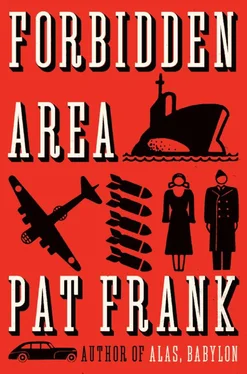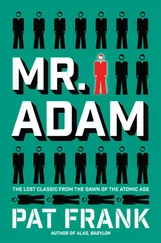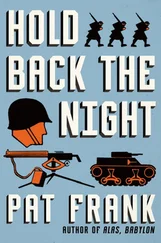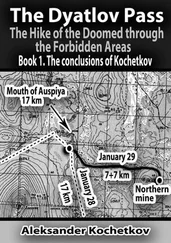For there was something else, unpublicized.
The B-99 had been rushed into production in a crash program. It had replaced the B-47 and the B-52 on the assembly lines, and on every SAC base, not only because of superior speed, range, and altitude. The difference wasn’t that important. The bomb bay of the 99 was no larger than that of the 47. When you can hide a small-city-size atomic bomb under a plug hat the bomb bay doesn’t have to be big. The fuselage of the 99 was somewhat longer than that of the B-52. All that extra space was crammed with new and strange electronic defenders. A bomber has deadly enemies, anti-aircraft rockets such as the Nike, launched from the ground, and the Navy’s Sparrow, fired from interceptors, and these enemies are smart. They have small inhuman eyes that guide them relentlessly to the bomber. The human brain piloting the bomber cannot outthink or outguess a guided missile. The human brain may decide to dodge, climb, weave, or dive, but the missile’s quicker brain will seek him out and destroy him. It takes a machine to outsmart a machine. The electronic machines inside the B-99 could distract a Russian missile’s one-track mind. They could take the missile’s thoughts off its task, and might even persuade it to turn traitor, and to return to the ramp from whence it was launched.
It was Keatton’s belief that the peace of the world, at that moment, rested with the B-99. This had not been true in the era of good feeling a few years before, and it might not be true a few years hence. But in that November, it was the existence of the B-99 and its pulsing metal brains that insured unbearable retaliation. It would be catastrophic if the enemy got hold of a B-99. It would be the end. They could pick its brains, learn its habits, and then build rockets to ignore its electronic tongues.
In his still, carpeted office down the main corridor from the River Gate, Keatton could not tear his mind away from the grotesque possibility that the B-99 had been stolen. As chief of an organization that was planning, among other fantastic things, to create an inhabited artificial satellite of earth, he could never forget that anything can happen. Keatton had no illusions whatsoever concerning his own future in the event of war. Whatever happened, he was through. If the enemy strike succeeded, in all likelihood he would either die very quickly, or be executed later. If he was called upon to strike their cities first, his soul could not survive the trauma of being an instrument of death for twenty or thirty or fifty million human beings. The worst of it was that ninety-nine percent of them were plain, ordinary people with no voice or choice in the schemes and ambitions of the leaders. Just people who wanted to work a little, play a little, love someone, and eat plenty. He couldn’t even be sure his strike would get the men in the Kremlin. When it happened, the bastards would be somewhere else. But if it did come, he would like to be certain that he could win it. For a protégé of Hap Arnold and Tooey Spaatz, it was a professional matter.
He called in Colonel Lundstrom, the Chief of OSI, and ordered him to Florida, just in case. OSI meant Office of Special Investigations, Air Force. He told Lundstrom to dig into the background of every crew member of the lost B-99. 2
The matter of the missing bomber did not become of transcendent importance until the third Monday of December.
On that day the Intentions Group met to review the final draft of a Russian war plan they had been constructing for eighteen months. Their plan was not complete, for while they believed they knew the answer to “How?” and “Where?” they could not presume to know when. Not that morning, they couldn’t.
That it had required eighteen months to produce a facsimile of a Russian plan of attack was not surprising. They took it for granted that Russian staffs had been working on the original for at least five years. The skeletal draft was not wordy. The stapled copy, No. 6, that lay on the table before Katharine Hume contained only twenty-eight pages of typescript. It was called, simply: FORECAST OF RUSSIAN MILITARY ACTION.
The philosophical basis for the forecast had been written by Simmons and Cragey. The Kremlin was aware that nothing could be decisive except what happened to the United States and its air power in the first twenty-four hours of war. Twice in the century the explosive industrial might of America had resolved world conflicts. It would again, if given time. To win a war, Russia had to destroy the industrial potential of the United States, and at the same time protect itself against atomic holocaust. So the plan began:
“OBJECTIVE: Destruction of 65-75 percent of the largest cities and industrial complexes, with populations; destruction of the Strategic Air Command; destruction of those carriers capable of mounting an attack on Russia proper.”
Since this objective, if fulfilled, would insure total victory, the plan could now follow the principle of war called “economy of force.” It discarded ground, sea, or air action in Europe and in Asia, with a single exception, unless directed at American air and naval bases. The exception was London. Other nations might be awed into submission by the blitz; the British, never.
Each time she read the first few pages of the forecast, as she had a hundred times as details were argued and altered, Katharine shivered. It was a plan ingenious and terrifying, but it would anger higher authority, particularly in the Continental Air Defense Command, and probably in the Army and Navy as well. Yet it was their duty to plan the destruction of the United States in the hope that someone else would think up a countermove to prevent it. It was not their duty to plan a defense. Indeed, Katharine wondered if defense were possible.
The guts of the forecast was that the main blow would be delivered not by air, as everyone anticipated, but by sea. Geography and the lethal trident of submarine, guided missile, and H-bomb, made their concept logical. Sixty-five percent of America’s heavy industry lay within three hundred miles of the sea, which meant within range of the old-fashioned German V-weapons. The Russians had much more efficient gadgets, and more of them, now. Several German rocket research establishments had fallen into Russian hands in 1945, along with thousands of technicians, tons of blueprints, acres of underground factories, and components by the carload. When the war ended the Germans had been working on a V-9, a two-stage rocket designed for transoceanic warfare. This work had not faltered, under Soviet direction.
To fathom the enemy’s intentions, it had first been necessary to determine his capabilities, and of course this had been the hardest part of the job. The Russians hold no open legislative hearings to decide whether their strategic air force shall have fifty or a hundred wings. Neither do they announce the composition of their Navy, or display motion pictures, publicly, of their new rockets.
Yet something always comes through. And an intelligence analyst works in much the same way as an archeologist. Give him a small bone, and often he can reconstruct the whole animal. So it was that Commander Batt could say that Russia’s submarine fleet comprised six hundred vessels, of which half were capable of long-range action against the shores of North America. Of these, two hundred were equipped with hangars or rocket-launchers, or both. The rockets had a range of five hundred miles and could be dropped within two miles of target. Armed with an H-bomb, this was the same as a direct hit. The submarine-launched rockets would drop at a speed of 3,500 miles an hour. Interception was next to impossible.
Katharine guessed, conservatively, that the Russian stockpile of H-bombs stood at three hundred and the annual production had been stepped up to one hundred. A few of these bombs, designed to contaminate vast inland areas, might be rigged with U-238 or cobalt casing, although this seemed as unnecessary as poisoning elephant-gun bullets to shoot mice. The nominal, ten-megaton bomb would sink Manhattan Island, kill almost everyone in the other boroughs by blast and heat alone, and spread a radioactive cloud that would fall over an area of seven thousand square miles down wind. Rigged with U-238, the fallout area would be as big as the state of Pennsylvania, and perhaps uninhabitable for several years.
Читать дальше












